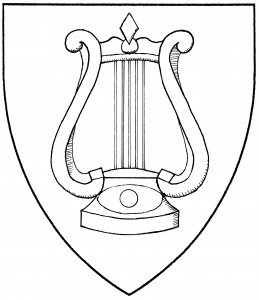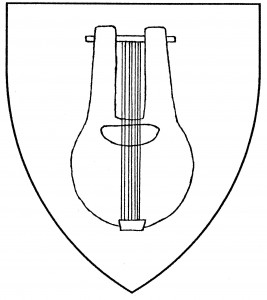A lyre is a stringed musical instrument of the zither family, played by the ancient Greeks. It had a sound box, with two projecting arms joined by a yoke; strings were stretched from the sound box to the yoke. The use of the lyre was revived in the Renaissance, as a symbol of the classical arts; it was then drawn in a stylized manner (as in the illustration), unlike the actual artifact. The lyre was a period charge, granted as a crest to the Worshipful Company of Musicians in 1604 [Bromley & Child 180].
Similar to the lyre are the “cithara”, a larger and more solidly built variant, with five to eleven strings; and the “crwth” (plural “crythau”), a Welsh instrument of similar construction. The lyre, cithara and crwth all have the same default orientation: strings palewise, facing the viewer, and the soundbox to base. For related charges, see harp.
The East Kingdom Musician’s Guild bears: Azure, in fess a panpipe argent and a cithara Or within a bordure argent.
Boadicia Artemisia bears: Argent, a Greek lyre sable.
Fiore Pescara bears: Gules, three lyres Or.
Rhonwen Y Clermont o’r Mwntduog bears: Per fess indented argent and sable, five crythau three and two counterchanged gules and argent.

